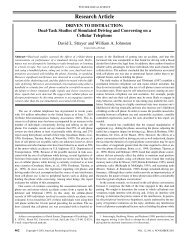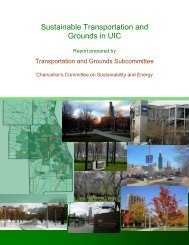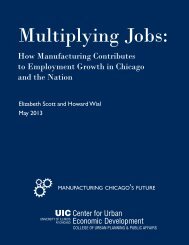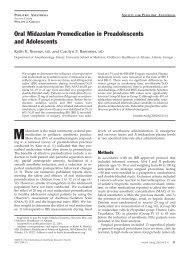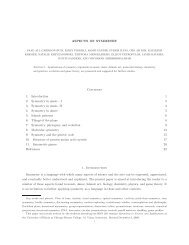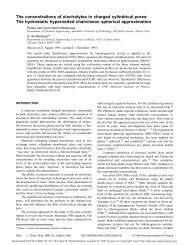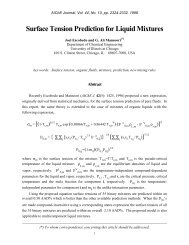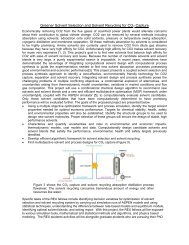High Levels of Gene Flow in Bur Oak Revealed by Paternity ...
High Levels of Gene Flow in Bur Oak Revealed by Paternity ...
High Levels of Gene Flow in Bur Oak Revealed by Paternity ...
You also want an ePaper? Increase the reach of your titles
YUMPU automatically turns print PDFs into web optimized ePapers that Google loves.
Here we report the application <strong>of</strong> a new<br />
type <strong>of</strong> genetic marker, polymorphic microsatellite<br />
DNA, for paternity analysis<br />
and poll<strong>in</strong>ation studies. Microsatellites are<br />
short, tandemly repeated simple sequences,<br />
1–6 bp <strong>in</strong> length, which are highly polymorphic<br />
for repeat number (Ashley and<br />
Dow 1994). Amplification <strong>of</strong> the microsatellite<br />
region <strong>by</strong> polymerase cha<strong>in</strong> reaction<br />
(PCR) results <strong>in</strong> fully penetrant, Mendelian<br />
<strong>in</strong>herited, codom<strong>in</strong>ant markers<br />
than can be precisely identified <strong>by</strong> length.<br />
Unlike allozyme loci, which do not have<br />
sufficient variability to determ<strong>in</strong>e parentage<br />
<strong>by</strong> exclusion (Chakraborty et al. 1988),<br />
each microsatellite locus has many relatively<br />
rare alleles, and <strong>in</strong> most cases all<br />
but one adult or all adults <strong>in</strong> the local population<br />
can be excluded from paternity us<strong>in</strong>g<br />
a few loci (Dow and Ashley 1996; Dow<br />
et al. 1995). Movement <strong>of</strong> successful pollen<br />
can then be traced <strong>by</strong> exam<strong>in</strong><strong>in</strong>g the<br />
relative locations <strong>of</strong> identified maternal<br />
and paternal trees, and gene flow from pollen<br />
can be estimated from the proportion<br />
<strong>of</strong> poll<strong>in</strong>ations <strong>in</strong> which all trees <strong>in</strong> a stand<br />
are excluded from paternity.<br />
The only assumptions required for microsatellite<br />
paternity analysis are that<br />
there are no mutations between parents<br />
and <strong>of</strong>fspr<strong>in</strong>g and that adults and <strong>of</strong>fspr<strong>in</strong>g<br />
with match<strong>in</strong>g genotypes are related. The<br />
mutation rate <strong>of</strong> microsatellite sequences<br />
has been estimated at 10 4 to 10 5 mutations<br />
per locus per generation (Edwards<br />
et al. 1992; Ellegren 1992; Schlötterer and<br />
Tautz 1992), which is low enough that the<br />
probability <strong>of</strong> a mutation between parents<br />
and <strong>of</strong>fspr<strong>in</strong>g is negligible. The probability<br />
<strong>of</strong> cryptic gene flow (an adult with<strong>in</strong> the<br />
stand match<strong>in</strong>g an acorn <strong>by</strong> chance when<br />
the acorn was actually fertilized <strong>by</strong> pollen<br />
from outside the stand) can be easily calculated<br />
based on allele frequencies (Westneat<br />
and Webster 1994).<br />
We apply microsatellite analysis to characterize<br />
successful pollen donors <strong>of</strong> <strong>in</strong>dividual<br />
seed parents. All adults <strong>in</strong> a stand<br />
<strong>of</strong> bur oaks (Quercus macrocarpa) <strong>in</strong> northern<br />
Ill<strong>in</strong>ois were genotyped at four variable<br />
microsatellite loci, and <strong>of</strong>fspr<strong>in</strong>g<br />
(acorns) <strong>of</strong> trees located <strong>in</strong> different parts<br />
<strong>of</strong> the stand were scored at these loci as<br />
well. The objectives <strong>of</strong> this study were to<br />
(1) evaluate the utility <strong>of</strong> microsatellite<br />
analysis for study<strong>in</strong>g paternity and successful<br />
poll<strong>in</strong>ation; (2) assess the amount<br />
<strong>of</strong> long-distance gene flow <strong>by</strong> determ<strong>in</strong><strong>in</strong>g<br />
the proportion <strong>of</strong> fertilizations effected <strong>by</strong><br />
trees not <strong>in</strong> the stand; (3) characterize the<br />
spatial patterns <strong>of</strong> pollen movement for<br />
fertilization occurr<strong>in</strong>g between paternal<br />
and maternal trees with<strong>in</strong> the stand; and<br />
(4) determ<strong>in</strong>e the rate <strong>of</strong> self-poll<strong>in</strong>ation <strong>in</strong><br />
bur oak.<br />
Materials and Methods<br />
Study Site and Species<br />
The study site is part <strong>of</strong> an abandoned<br />
farm located <strong>in</strong> McHenry County near Harvard,<br />
Ill<strong>in</strong>ois, which was released from agriculture<br />
approximately 20 years ago. The<br />
stand occupies an area approximately 200<br />
m 250 m and consists <strong>of</strong> 62 mature bur<br />
oaks (Q. macrocarpa Michx.) and 16 red<br />
oaks (Q. rubra L.), and likely represents a<br />
fragment <strong>of</strong> presettlement oak savanna. All<br />
adults trees were mapped us<strong>in</strong>g angle and<br />
distance.<br />
Q. macrocarpa is a monoecious, dicogamous,<br />
deciduous tree. On a s<strong>in</strong>gle tree,<br />
male flowers mature and release pollen before<br />
female flowers become receptive to<br />
pollen. Q. macrocarpa is known to hybridize<br />
with Q. alba and Q. muhlenbergii, but<br />
is not known to hybridize with Q. rubra<br />
(Jones 1963). <strong>Oak</strong>s are mast<strong>in</strong>g species,<br />
produc<strong>in</strong>g variable crops <strong>of</strong> acorns <strong>in</strong> different<br />
years. Every tree produced pollen<br />
every year <strong>in</strong> the 3 years that observations<br />
were made. Acorn production varied<br />
among <strong>in</strong>dividual trees. A few trees produced<br />
large crops <strong>of</strong> acorns every year,<br />
but most trees had no observable acorn<br />
production <strong>in</strong> at least 1 year. A coord<strong>in</strong>ated<br />
reproductive effort among all trees was<br />
not observed.<br />
Sample Collection and Microsatellite<br />
Amplification<br />
In early May 1992 and 1994, young leaves<br />
(0.5–2.0 cm long) from each <strong>of</strong> 62 adult<br />
bur oaks at the study site were collected<br />
just after bud break, when tann<strong>in</strong> content<br />
is lowest (Feeny 1970), quick frozen and<br />
stored at 70C. Because our purpose was<br />
to develop a detailed understand<strong>in</strong>g <strong>of</strong><br />
pollen sources used <strong>by</strong> <strong>in</strong>dividual trees,<br />
our sampl<strong>in</strong>g strategy was to exam<strong>in</strong>e as<br />
many acorns as possible from each <strong>of</strong> a<br />
few trees located <strong>in</strong> different parts <strong>of</strong> the<br />
stand. This strategy was expected to reveal<br />
any directional bias <strong>in</strong> poll<strong>in</strong>ation<br />
(e.g., fewer with<strong>in</strong>-stand pollen donors on<br />
the upw<strong>in</strong>d side <strong>of</strong> the stand), distribution<br />
<strong>of</strong> pollen donors around the seed parents<br />
and fertilizations from outside <strong>of</strong> the<br />
stand, which we assumed would be rare.<br />
Acorns were collected from 11 trees, with<br />
the largest crops <strong>in</strong> late August and early<br />
September 1992. Equal numbers <strong>of</strong> acorns<br />
were collected from all sides <strong>of</strong> the tree.<br />
Sound acorns were separated from <strong>in</strong>sect-<strong>in</strong>fested<br />
acorns <strong>by</strong> flotation, stratified<br />
<strong>in</strong> damp sand at 4C for 2–3 months (USDA<br />
1974), and grown <strong>in</strong> a greenhouse. Three<br />
groups <strong>of</strong> half-sibs were found suitable for<br />
this study based on a sample size <strong>of</strong> 96<br />
surviv<strong>in</strong>g seedl<strong>in</strong>gs and location <strong>of</strong> maternal<br />
tree. One maternal tree was located on<br />
the east side (tree 3E), one was <strong>in</strong> the middle<br />
(tree 17M), and one was on the west<br />
side (tree 33W) <strong>of</strong> the stand. Germ<strong>in</strong>ation<br />
rates <strong>of</strong> acorns from these trees were 92%,<br />
98%, and 95%, respectively. All <strong>of</strong> these<br />
trees were at least 100 m from any tree<br />
outside <strong>of</strong> the stand to the north and<br />
southeast, and greater than 300 m from<br />
conspecifics <strong>in</strong> any other direction (Figure<br />
1). Fully expanded leaves <strong>of</strong> seedl<strong>in</strong>gs<br />
were quick frozen and stored as above.<br />
DNA was extracted from frozen leaves <strong>of</strong><br />
adults and seedl<strong>in</strong>gs us<strong>in</strong>g previously published<br />
protocols (Dow et al. 1995). Amplification<br />
<strong>of</strong> microsatellite loci was performed<br />
us<strong>in</strong>g four primer pairs (MSQ3,<br />
MSQ4, MSQ13, and MSQ16), and genotypes<br />
were scored <strong>by</strong> PCR product length<br />
at each locus as described previously<br />
(Dow and Ashley 1996; Dow et al. 1995).<br />
Differences <strong>in</strong> allele frequencies between<br />
adults and acorns was tested <strong>by</strong> us<strong>in</strong>g<br />
the Kolmogorov–Smirnov test as <strong>in</strong><br />
Mor<strong>in</strong> et al. (1994). The Kolmogorov–Smirnov<br />
test is a nonparametric test <strong>in</strong> which<br />
frequency distributions are arranged cumulatively,<br />
then compared between two<br />
groups. The largest difference <strong>in</strong> cumulative<br />
frequency distribution is the test statistic<br />
D, which has associated critical values<br />
(Ebdon 1985).<br />
Assignment <strong>of</strong> Parentage<br />
Because Mendelian <strong>in</strong>heritance had been<br />
previously established for the microsatellite<br />
loci (Dow et al. 1995), each acorn was<br />
expected to have two alleles per locus for<br />
four loci, one allele derived from each <strong>of</strong><br />
that <strong>in</strong>dividual’s parents. The four loci<br />
used as markers were not l<strong>in</strong>ked. To<br />
match the acorn paternal alleles with the<br />
putative pollen donor, all possible gametes<br />
for each adult (maximum for complete<br />
heterozygosity 2 4 16) and the<br />
paternal alleles <strong>of</strong> each acorn were entered<br />
<strong>in</strong>to a database. If an <strong>of</strong>fspr<strong>in</strong>g<br />
matched both maternal alleles at a locus,<br />
mak<strong>in</strong>g it impossible to dist<strong>in</strong>guish which<br />
allele had come from the pollen donor,<br />
both alleles were entered <strong>in</strong>to the database<br />
with all comb<strong>in</strong>ations <strong>of</strong> its other alleles.<br />
Alleles were grouped at each locus<br />
<strong>in</strong> turn us<strong>in</strong>g the ‘‘sort’’ function <strong>of</strong> the database,<br />
which resulted <strong>in</strong> the match<strong>in</strong>g <strong>of</strong><br />
like genotypes over all four loci. If the pa-<br />
Dow and Ashley • <strong>Bur</strong> <strong>Oak</strong> <strong>Gene</strong> <strong>Flow</strong> 63





